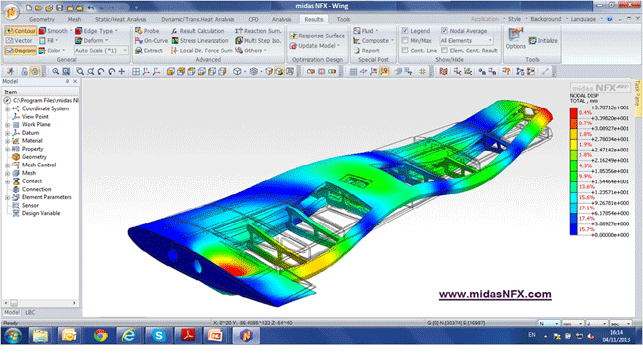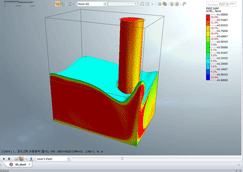Simulation adoption in the mainstream is growing, driven by the need to develop more optimised and efficient products along with more readily accessible (read: CAD integrated and bundled) tools.

midasNFX’s ribbon based UI guides you through the set-up and solve process for all manner of simulation tasks
As users become more sophisticated in their simulation, moving beyond basic linear static and modal analysis, so does the sophistication of their toolset.
More than ever before users are pushing the boundaries of what they can simulate. Simultaneously, we’re also seeing a growing number of tools and increasing software licensing costs.
Let’s face it, if you’re doing explicit dynamics, looking to mix together multiple physics, then you often need more software to do it.
Whether you use the same tools (but extended) or follow the best of breed route, as your simulation use advances, your costs, both of software and training, advance commensurately.
So with this in mind, it’s interesting that Korean outfit, Midas, has introduced its midasNFX solution set.
For those not familiar with the name, Midas has been most prevalent in the civil engineering simulation space. Its range of Midas Civil tools is well known amongst those involved in the business of designing bridges, buildings and other massive structures.
Four years ago the company took the same in-house developed simulation code and four years ago released a set of tools that focus squarely on the mechanical engineering space. This is called midasNFX.
So, let’s have a look-see at what it can do and how it does it.
User experience
midasNFX looks and feels pretty much like every other Windows-based application — and this is undoubtedly a good thing. It takes the Windows ribbon user interface (UI) style and adapts it nicely for the simulation workflow.
In terms of how that workflow plays out, the operations are split into two key stages; Set-up of your models under the Model & LBC (loads and boundary conditions) and the Analysis and Results panels. Each has clear operations and icons and the workflow typically moves from left to right, to take you through the process.
It’s also worth noting that the system can be run in one of two ‘modes’. The ‘designer’ mode sets you up for importing geometry from a CAD system, clean up, then steps you through the process.
The ‘Analyst’ mode is much the same but opens up the geometry creation tools for those looking to build models from scratch. Neither are exclusive, but rather tailored to the user’s current workflow and processes.
Study set-up
In terms of model definition, there are a number routes to preparing geometry for simulation. NFX targets both the engineer and the analysis expert and, as such, supports both groups of users’ requirements, with of course some overlap between the two.
Models can be imported using a wide range of geometry formats, including standards such as STEP, but also a good mix of native formats.
If you’re looking to bring in data from other simulation tools, there’s also an option for importing NASTRAN decks, which are pretty standard in most systems.
The system also supports the creation of geometry from scratch or derivation from imported geometry.
An excellent example is the use of mid-plane models. NFX includes tools to take the source geometry and extract the planes required (which are then assigned a thickness) to assist with processing.
As anyone that’s involved in simulation will know, the raw geometry from a CAD system is often too complex or needs a little tender loving care to prepare it for efficient simulation. Again, NFX has the tools needed to repair (think consolidation of small edges or faces) defeature (removal of fillets and small features) and abstract the model.
Meshes, loads & boundaries
Now this is an area in which Midas’ expertise across a broad range of technologies, and the support of that breadth in the system, comes into play. Unlike most other simulation codes, which specialise on one or two areas, Midas enables the use of the same core geometry to perform all manner of simulations.
As such, the meshing and materials assignments are disconnected from each other. For example, when you define materials, this is done to the input geometry, rather than the meshed. The same is true of the loads and boundaries you define.
This means that you can have the same study set-up (in terms of geometry, materials, constraints etc.), but create different meshes for different study types. These same set-ups can then be used for all manner of simulations.
Solve & calculation
Solving is never a particularly fun thing to talk about as it basically involves just sitting and waiting for a job to finish.

To see an illustration demonstrating CAD to SIM: Scaling complexity with a single tool, click here
The good news for midasNFX users relates to how the company licenses its software and today’s high performance, multi-CPU/Core workstations.
A lot of the more traditional simulation vendors still license per CPU, which to my mind, makes little sense at the workstation level.
If you’ve got a workstation, you should be able to use all of the power available. Midas takes a different approach and if you’ve got the multi-CPU/Cores available, you can use them.
Post Process & Results
The post processing tools are just as you would expect. Job completes, then you dive into it to find out the results.
It covers all the bases from automatically generated reports, through to graphing, slicing and dicing as you need — bearing in mind that the system covers both structural as well as fluid related simulation, all the tools are there.
Costs
So, midasNFX includes pretty much all of the key technologies you’d need to carry out more advanced simulation in a CAD integrated environment.
But what of costs and licensing? As experienced simulation users will be aware, the higher-end simulation world is a complex one when it comes to licensing.
Being more advanced tech, costs are always going to be higher but the conditions of those costs are often out of kilter with the expectations of mainstream designers and engineers. Annually payable licenses are prevalent (rather than a perpetual license with support/maintenance) and there’s also the issue of per core or per CPU licensing.
While many of the high-end vendors are addressing this, it’s still the case that if you want to take advantage of today’s high spec’ed workstations, you have to acquire additional licenses to run those cores at full pelt. Midas side-steps this issue by not charging on a core or CPU basis. You buy the software and you can use it across as much hardware as you see fit or have available.
Conclusion
When all is said and done, midasNFX doesn’t offer dramatically different simulation technology per se, although the same can be said of every simulation system — after all, physics is physics.
However, what makes the system stand out is that you get access to everything, from static linear structural, through more advanced structural simulation and then into the realms of topology optimisation (which we haven’t covered here) and into Computational Fluid Dynamics.
Data is also eminently reusable between different studies and different simulation types, where appropriate.
That means you can actually discover more about how your product performs without switching systems and having to redo set-up work.
//www.youtube.com/embed/ngexfpBOOnI?list=PLdiHDbg1RtypPyfKO53ljah1zZNtexp2b







